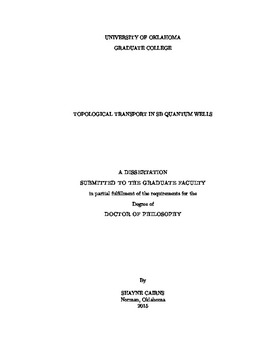| dc.description.abstract | The following dissertation will cover the initial studies of Sb quantum wells as topological insulators. The theoretical background and previous studies of topological insulators are covered first, to set the foundation for future discussion. The idea of topology is discussed and how it relates to physical systems like the quantum Hall state is described. Then the theory behind topological band structure and the Z$_2$ topological insulator system is discussed. This is followed by the experimental observations of topological insulators in 2D and 3D systems. Sb as a topological insulator is introduced in relation to the the first 3D topological insulator observed in Bi-Sb alloys. Due to the large conduction in bulk Sb, quantum confined Sb wells are grown by molecular beam epitaxy (MBE) to reduce bulk conduction.
Sb quantum wells grown by MBE on two types of substrates, GaAs(111) and GaSb(111). Before growth of the Sb well, a 0.5\,$\mu$m GaSb buffer was grown to provide an excellent lattice matched surface, as GaSb and Sb in the (111) direction have less than a 0.1\% lattice mismatch. The initial Sb wells ($\sim$ 30 samples) were grown on GaAs(111) substrates, using two different growth procedures. Surface studies of Sb wells showed a large amount of dislocations originating from the lattice mismatch between the GaAs substrate and GaSb buffer layer; hence a second series of wells was grown on GaSb(111) substrates to alleviate this problem. GaSb substrates from three different manufactures were used: Wafer Tech, New Way Semiconductor, and Galaxy Wafer. Multiple substrate manufacturers were used depending on existing supply at the University, cost of substrates, and availability. Sb wells grown on New Way substrates showed poor quality when compared to wells grown on Wafer Tech and Galaxy substrates and were hence discontinued. Sb wells of excellent quality were then fabricated into Hall bar devices and nano-wire devices.
Standard device processing steps presented unexpected issues when applied to Sb wells and a revised procedure was formulated. Nano-wire devices were fabricated using electron beam lithography (EBL) and reactive ion etching (RIE). Magneto-transport and quantum interference experiments were then conducted.
To better understand the effects seen in magneto-transport measurements, classical magneto-transport and quantum interference theory is covered. The classical magneto-resistance effect is introduced along with quantum interference effects (e.g. weak localization). These effects are used to explain low and high field data. Zero field conductance measurements show reduced bulk conduction and residual surface conductivity at zero well thickness. Low field measurements exhibit a strong weak anti-localization (WAL) effect that dissipates with increasing temperature. Fits to WAL data using a theoretical model by Hikami, Larkin, and Nagaoka agree well with experiment and a determination of the phase breaking length and $\alpha$ pre-factor is possible. The temperature and thickness dependence of the fitting parameters was investigated. High field magneto-transport is done in tilted field to determine whether the observed magneto resistance is 2D or 3D in origin. An evolution of the high field magneto resistance from parabolic (B$^2$) to linear (B) field dependence is seen for decreasing well thickness. This effect can be reproduced using a simple model containing bulk and WAL terms in concert. Initial measurements of nano-wire devices show the presence of universal conductance fluctuations (UCF), but more work is required to form a complete picture.
In conclusion, the Sb quantum wells in this study show reduce bulk conduction when compared to bulk films. Also the presence of residual conduction at zero well thickness indicates surface transport as expected for a 3D topological insulator. Parameters determined from WAL fitting are independent of well thickness which points to 2D surface conduction. This is also seen in tilted field measurements when data is plotted versus perpendicular field. All of these results point towards 2D surface conduction with a bulk background which is confirmed by the simple model used to explain high field magneto-transport data using surface and bulk channels in parallel. | en_US |
